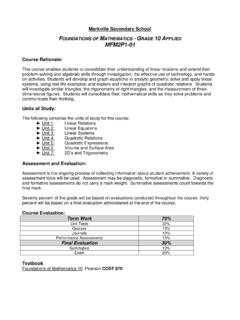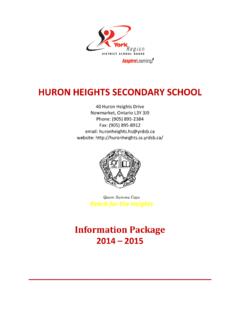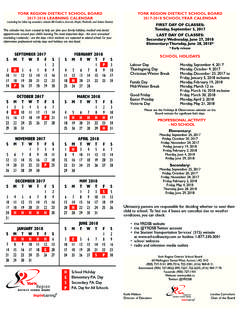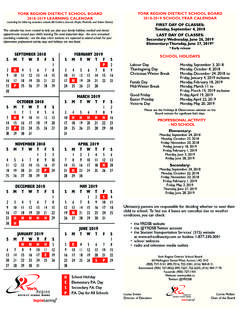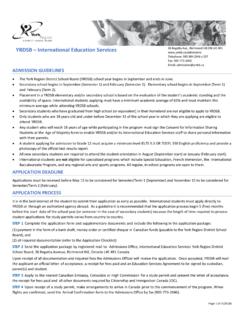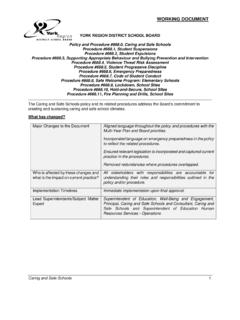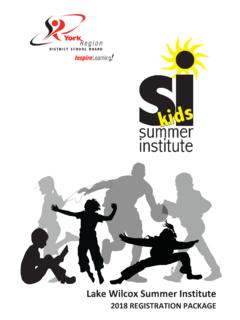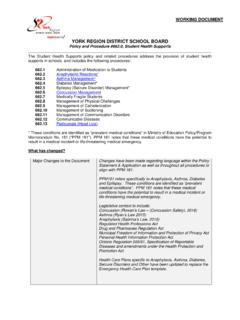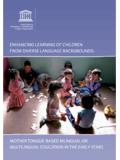Transcription of The Ontario Curriculum, French as a Second …
1 6 INTRODUCTIONVISION AND GOALS OF THE French AS A Second language CURRICULUMAll programs in the French as a Second language curriculum at the elementary and secondary levels share a common vision, as follows: Vision and Goals for French as a Second language Core, Extended, and Immersion, Grades 1 to 12 VisionStudents will communicate and interact with growing confidence in French , one of Canada s official languages, while developing the knowledge, skills, and perspectives they need to participate fully as citizens in Canada and in the world . GoalsIn all French as a Second language programs, students realize the vision of the FSL curriculum as they strive to: use French to communicate and interact effectively in a variety of social settings; learn about Canada, its two official languages, and other cultures; appreciate and acknowledge the interconnectedness and interdependence of the global community; be responsible for their own learning, as they work independently and in groups; use effective language learning strategies; become lifelong language learners for personal growth and for active participation as world order to achieve the goals of the elementary and secondary FSL curriculum, students need to: acquire a strong oral foundation in the French language and focus on communicating in French ; understand the value of learning another language .
2 Develop the skills needed to strengthen traits of resilience and to secure a sense of self, through opportunities to learn adaptive, management, and coping skills, to practise communication skills, to build relationships and interact positively with others, and to use critical and creative thinking IMPORTANCE OF French AS A Second language IN THE CURRICULUMThe ability to speak and understand French allows students to communicate with French -speaking people in Canada and around the world, to understand and appreciate the history and evolution of their cultures, and to develop and benefit from a competitive advantage in the workforce. 7 INTRODUCTIONW hile the knowledge of any language has value, French is not only a global language but the mother tongue of many Canadians and an integral part of the Canadian identity. Learning French equips students to communicate with French -speaking Canadians and millions of French speakers around the addition to strengthening students ability to communicate, learning another language develops their awareness of how language and culture interconnect, helping them appreciate and respect the diversity of Canadian and global societies.
3 When a student is exposed to another culture through its language , he or she begins to understand the role that language plays in making connections with others. Learning an additional language not only challenges a mind, it also teaches understanding, encourages patience, and fosters open-mindedness. Knowledge of an additional language strengthens first- language skills. The ability to speak two or more languages generally enhances cognitive development, as well as reasoning and creative-thinking skills. It also enhances the student s confidence as a learner, facilitates the learning of additional languages, and contributes to academic achievement. As their strengths develop, French language learners become more flexible and adaptable in new and unforeseen situations. For example, Second - language learners tend to be more divergent thinkers, with improved memory and attention span. Positive outcomes for students in the FSL curriculum include: increased mental flexibility; improved problem-solving skills; a better understanding of aspects of a variety of cultures; a greater awareness of global issues, including those related to the environment and sustainability; expanded career ability to speak both of Canada s official languages helps prepare students for their role as active and engaged citizens in today s bilingual and multicultural Canada.
4 Moreover, the language learning strategies that students develop in the FSL program can contribute to an interest in learning languages throughout their lives and provide them with the skills to do so. Such abilities benefit the individual; but Canadian society as well as the global community also stands to gain from having plurilingual ENDURING IDEAS IN THE French AS A Second language CURRICULUM By studying a Second language , students learn a great deal about interacting effectively with others, because they have to focus closely on what it is they are trying to communicate; what they need others to understand, and why; how their oral or written expression is received and interpreted; and what others are trying to communicate to them, and why. As they learn to exchange information and ideas in another language , they also learn about other ways of thinking, other ways of doing things, and other ways of living in short, about other people and other cultures.
5 3. For more information on plurilingualism, see Council of Europe, Plurilingual Education in Europe: 50 Years of International Co-operation, Strasbourg, February 2006; available at 8 THE Ontario CURRICULUM | French as a Second LanguageThe French as a Second language curriculum emphasizes communicating a message by using knowledge of vocabulary, language conventions, and grammar while taking into consideration the purpose, the audience, and the situation or context. This focus on the sociolinguistic and cultural aspects of language allows students to apply their language knowledge in a variety of real-world situations and contexts. Through the study of French , students experience multiple opportunities to communicate for authentic purposes in real-life situations. These opportunities enable students to build on and apply their knowledge of French in everyday academic and social situations, thus developing effective communication skills.
6 Students can take control of their learning through observation, listening, and rehearsing with others; refining their use of language ; and making thoughtful and meaningful connections to the world around them. If students see aspects of the FSL curriculum modelled and reinforced by educators, family members, and community members, their learning is reinforced and validated as more relevant to their FSL curriculum strives, ultimately, to foster an interest in language learning that continues not only during a student s time in school but later in life. The FSL curriculum is therefore founded on seven fundamental concepts, or enduring ideas , which focus, from Grade 1 to Grade 12, on the development of skills that are also necessary as a basis for lifelong language learning. These enduring ideas are discussed below. Goal Setting and ReflectionEmphasis on Critical and Creative Thinking SkillsMaking Real-World ConnectionsLifelong language LearningInterdependence of language and CultureAuthentic Oral Communication:Reception, Production, and InteractionListening, Speaking, Reading, and Writing: Interconnected but DistinctDevelopment of language Learning Strategies9 INTRODUCTIONA uthentic Oral Communication: Reception, Production, and InteractionThe main purpose of learning a language is communication.
7 Communication is a social act. In order to learn French , therefore, students need to see themselves as social actors communicating for real purposes. Teaching language as a system of disconnected and isolated components gives learners some knowledge of the language , but does not allow them to use the language effectively. In contrast, communicative and action-oriented approaches to teaching French put meaningful and authentic communication at the centre of all learning activities. To reach their potential, students need to hear, see, use, and reuse French in meaningful yet developmentally appropriate contexts. One of the key terms in Second - language learning is comprehensible input . It is the teacher s responsibility to provide compre-hensible input, ensuring that the messages that students receive are understandable. Making the input relevant to the learner, the context, the situation is one way of doing this. Repetition and recycling are also integral to making input comprehensible.
8 Effective comprehensible input must be slightly challenging in order to provide the scaffolding students need to be able to begin producing that is, speaking and writing French in an authentic way. In order to go beyond receptive skills, students need to use and negotiate the input they receive by conversing in authentic situations. Interaction in French is pivotal in this curriculum. Research indicates that language instruction must provide significant levels of meaningful communication and interactive feedback in the target language in order for students to develop language and cultural proficiency. It is therefore recommended that teachers and students use French both inside the classroom and, when feasible, beyond it. Listening, Speaking, Reading, and Writing: Interconnected but DistinctIn order to develop the skills necessary to become lifelong language learners, students will be given multiple opportunities to: listen and respond to texts and to others; speak and interact with others; read, view, and respond to a variety of texts; write a variety of texts for many different purposes and and speaking skills are the springboards to reading and writing.
9 While the curriculum strikes a balance between these four distinct but interconnected skills, oral communication listening and speaking is paramount for Second - language acquisition. If students hear it, they can say it. If students can say it, they can read it. And if students can read it, they can write it. Development of language Learning StrategiesSuccessful French language learners use a number of strategies to learn more effectively. These language learning strategies are often categorized as cognitive, metacognitive, and social/affective. Cognitive strategies involve the direct manipulation of the language itself, such as remembering information and understanding or producing messages in French . Metacognitive strategies involve planning, thinking about the learning process as it is taking place, and monitoring and evaluating one s progress. Social and affective 10 THE Ontario CURRICULUM | French as a Second Languagestrategies enhance cooperation and help students regulate their emotions, motivations, and attitudes as they learn French through interacting with students will benefit from explicit classroom instruction regarding the use of French language learning strategies in authentic and relevant contexts.
10 It is important to note that the language learning strategies are not grade or program specific and that they are used to help students communicate effectively and make meaning in their daily interactions and activities. Once students are consciously aware of strategies, have practised using them, can select the most effective ones for a particular task, and can see the link between their own actions and their learning, they will be able to monitor their use of the strategies, set goals for improvement, and become more motivated and more effective French language learners. Interdependence of language and CultureLanguage and culture are strongly intertwined. language is not only a major aspect of culture, but also a means of accessing other cultural manifestations. Understanding the language is a major advantage when exploring other aspects of a culture. When studying a language , and the cultures in which it is spoken, students need to recognize that cultures are not homogeneous: diversity exists not only between but also within cultures.
